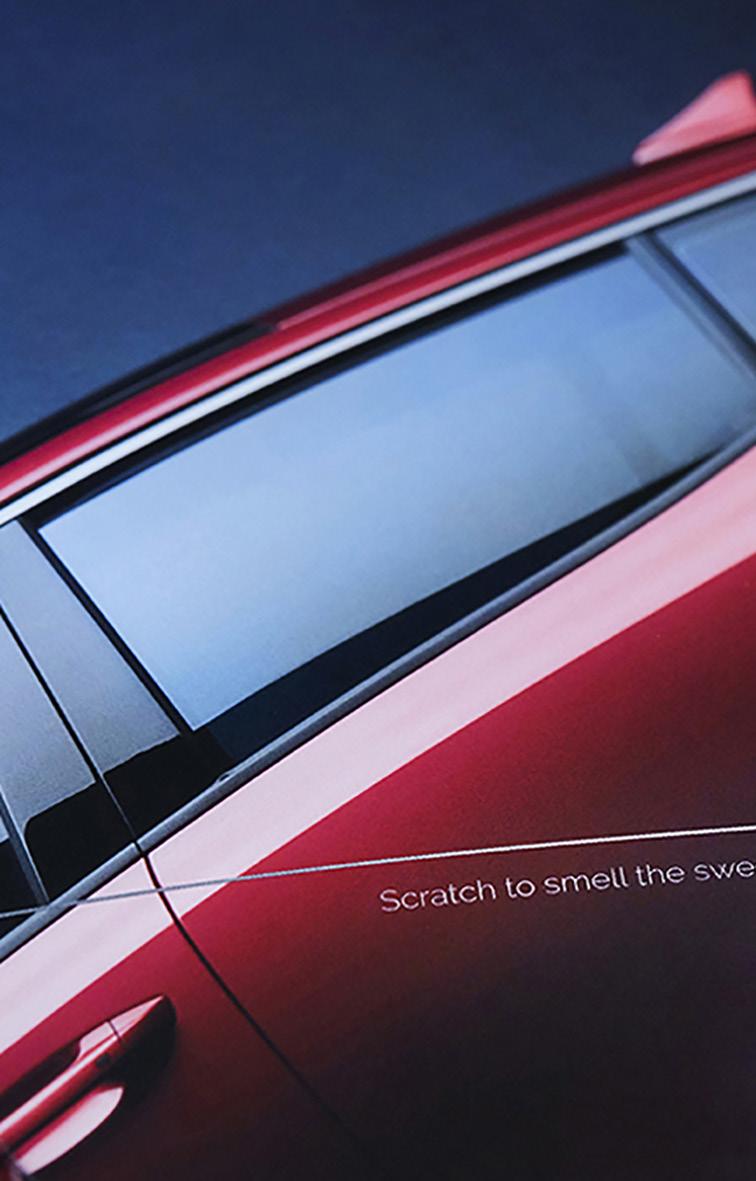
4 minute read
Print products and our senses" Getting a taste for it
We perceive the world through our five senses: Seeing, touching (feeling), tasting, hearing and smelling. In the last two blog posts, we dealt with the perception of printed matter through the senses of seeing and touching. But can you also taste, hear and smell print products? Absolutely. Be inspired by the possibilities.
“Did you enjoy your meal?” you will be asked in a restaurant. If you answer the question in the affirmative, your sense of taste has triggered positive feelings in you. How does the sense of taste actually work?
Historically, the sense of taste – a socalled proximity sense – was vital for survival. Our ancestors used it to test whether food was edible. For example, they preferred to stay away from bitter and sour tasting plants because the taste indicated that they might be poisonous.
The X factor from edible paper
Put simply, the sensory cells of the taste organ are located on the tongue. We can distinguish between five flavors:
sweet, sour, salty, bitter and umami (named after the discoverer, it stands for savory-spicy). So far, so good. And what does this sense have to do with printed material? The answer is, at hand, or on the tip of your tongue: Edible paper is available in a wide variety of flavors. The paper can even be printed with food coloring.
Edible printed matter is guaranteed to cause a surprise. Be it with or without an imprint: Who can resist the temptation to check the advertised edibility of paper and let the taste melt in their mouth? Anyone who has acquired a taste for this description can put it to the test: You can buy edible paper at many kiosks and major retailers.

Prick up your ears
We also perceive printed material by hearing. For example, most people find the sounds they make when browsing newspapers, magazines or books pleasant. The reason for this is simple: Most of us have known the sound since our childhood. It's familiar to us and arouses positive feelings.
Many miss these sounds when using the digital counterparts to newspapers, magazines and books. State-of-the-art technologies also enable the graphic arts industry to integrate additional acoustic elements into print products, thereby rewarding the so important sense of hearing.
Children's books with sounds
Above all, children's books producers are increasingly focusing on incorporating as many sensory
experiences as possible – in addition to visual and haptic effects, acoustic stimuli also encourage reading and contribute to a better understanding. Children and toddlers thereby experience in a playful way what the cow pictured in the little book sounds like, for example. A piece of cloth may even simulate the feel of its fur. The more perception levels are addressed, the greater the learning effect and fun. After all, let us be honest, we adults also enjoy books that appeal to several senses.

Electronic finish in advertising
Technological advances are making it possible to produce and sell cards with sound effects at a reasonable cost. For example, the stands with a huge selection of greeting cards always feature cards with sound effects. The surprise effect is guaranteed because the experience when opening the card arouses joyful emotions. The ideas are becoming increasingly unusual.
While the same "Happy Birthday" song used to ring out from practically every card in the past, many more songs have been added in the meantime, and there are already cards with a built-in chip on which you can load your own voice message or song –much to the delight of the recipients. The advertising industry is also taking advantage of this desirable effect. For example, by using electronically refined packaging solutions that make for a surprising appearance. Imagination knows no bounds.
A fine thing
Last, but not least, printed material is also perceived by the nose. In actual fact, in the graphic arts industry, the sense of smell can also be processed in printed products with the appropriate technological aids and machines. Scent strips have been known for a long time in advertisements in women's magazines. In combination with scratch-off ink, scented coatings are enjoying growing popularity and are increasingly being used in mailings or as test strips on all kinds of products (for example, on the packaging of scented sticks or laundry perfume).
The trick is simple: The odor is released by rubbing or applying pressure to the partially or fully printed microcapsules containing fragrances. When these microcapsules burst open, they give off a fine scent of fresh apples, delicate roses, oriental amber, Christmas aniseed and much more.
Scented coatings have an impact
Scented coatings arouse pure emotions and guarantee that advertising does not degenerate into a bog-standard matter. The use of printing coating is common in some industries. For example, the cosmetics industry uses scented coatings in its packaging, and car dealerships use them in their brochures to simulate the scent of leather seats. The world of fragrances is almost infinite. Many more ideas are conceivable and are waiting to be implemented.
The conclusion: We perceive the world through our five senses. And all senses can be addressed with print products. I wish you every success in your implementation!
by Ronald Reddmann - Muller Martini











